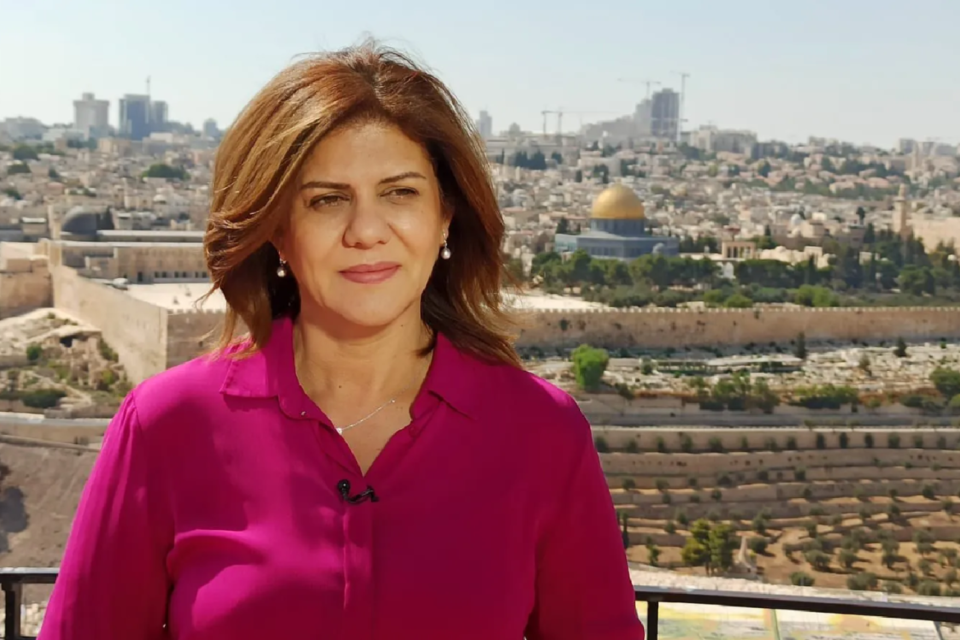Al Jazeera Reporter Was on West Bank
Scant Coverage for Trapped African Miners
Nieman Announces Diverse Class for 2023
60 Ukrainians Apply for Hampton’s Free Summer
From May 9:
Dreams Validated at Pulitzers
Nominate a J-Educator Who Promotes Diversity
Home page photo: Shireen Abu Akleh (Credit: Al Jazeera)
Support Journal-ismsMujahed al-Saadi, who was covering Israel’s operation in Jenin, West Bank, on Wednesday alongside Shireen Abu Akleh, told CNN that Abu Akleh and other journalists made themselves known to Israeli forces before they were shot at. “I saw Shireen on the ground,” he said. “We tried to rescue Shireen and we couldn’t.” (Credit: Al Jazeera)
Al Jazeera Reporter Was on West Bank
“The Arab world blamed IDF soldiers for the shooting of prominent Al Jazeera journalist Shireen Abu Akleh on Wednesday morning, which occurred during clashes that broke out in Jenin” on the West Bank, the Jerusalem Post reported on Wednesday. The reference is to Israeli Defense Forces.
“Arab leaders accused Israel and the IDF of systematic terrorism, premeditated murder and intentionally targeting free speech.”
Abu Akleh is described as a Palestinian American, born in Jerusalem. She graduated with a bachelor’s degree in journalism and media from Al Yarmouk University in Jordan, Al Jazeera said.
“She spent time in the United States when she was younger and obtained U.S. citizenship through family on her mother’s side, who lived in New Jersey, friends and colleagues said,” the New York Times reported.
On “Democracy Now!” Wednesday, Abu Akleh’s friend and colleague Dalia Hatuqa said, “Shireen and I met many years ago in D.C. when we both worked for Al Jazeera. She was stationed at the Ramallah bureau, but she was seconded to the D.C. bureau for a bit. So, we instantly became friends. . . .
“She gave voice to the struggles of Palestinians over a career spanning nearly three decades. Her killing is not an isolated incident. This has been happening for a long time: Israeli attacks against media workers, especially Palestinians, and the relative impunity under which they operate. . . .
“I personally have no faith in any probe that’s done by the Israelis. Many people have died, and no one has been held accountable for their death. And perhaps this will be a bit different because Shireen is an American citizen. But that leads us to the question: Why is being an American way more worthy of a probe than any other Palestinian, really?”
The International Federation of Journalists wrote that it “strongly condemned this latest targeted killing of a Palestinian media worker and has pledged to add the murder to the case lodged at the International Criminal Court (ICC) which details the systematic targeting of Palestinian journalists. . . .
“Al Jazeera producer, Ali Samoudi, was also shot in the back with a live bullet. Samoudi is reported to be in stable condition.”
CNN quoted journalist Mujahed al-Saadi, saying that Abu Akleh and other journalists made themselves known to Israeli forces in the area before they were shot at.
“ ‘I saw Shireen on the ground,’ he said. ‘We tried to rescue Shireen and we couldn’t.’
“The occupation targeted Shireen while wearing a helmet, the injury was under the ear,” he added. “Shireen fell while she was wearing press (gear) and even with that the people who tried to save her were shot at, the targeting was clear against Shireen and against us as journalistic teams.”
The Associated Press noted: “During last year’s war between Israel and Gaza’s militant Hamas rulers, an Israeli airstrike destroyed the building in Gaza City housing the offices of The Associated Press and Al Jazeera. Residents were warned to evacuate and no one was hurt in the strike. Israel said Hamas was using the building as a command center but has provided no evidence.”
In Burkina Faso, rescuers continue to pump water in the hope of finding the eight miners trapped in a zinc mine for more than three weeks. (Credit: France 24/YouTube)
Scant Coverage for Trapped African Miners
In 2010, the world was riveted by the rescue of 33 miners from a collapsed mine in Chile. The men “became a symbol of hope and solidarity,” by one account.
A movie documented their experience.
One billion people watched the rescue on live television.
Today in the west African country of Burkina Faso, eight miners have been trapped since April 13 by the collapse of a zinc mine. Americans barely know about it.
” ‘We are hopeful, yet angry at the same time,‘ said Yakouba Bama, whose cousin Charles Bama is one six of Burkinabès missing, along with one worker from Tanzania and another from Zambia,” Nomsa Maseko reported Tuesday for the BBC.
“The case has caused outrage in Burkina Faso as rescue operations only got under way following protests and a sit-in at a government building at a nearby town five days after the floods.
” ‘We don’t know if there’s enough oxygen for them and no-one is supplying them with food,’ the cousin said about the family’s concerns.
“Brenda Mwamba, wife of trapped Zambian miner Nune Ndonji, told BBC Focus on Africa radio that communication about the rescue efforts had been appalling — and it had taken five days for the mine managers in Burkina Faso to contact her directly in Zambia about what was going on. . . .”
Mwamba also reported, “The Canadian owners of the mine – which is about 100km (60 miles) west of the capital, Ouagadougou — say search crews continue to work 24 hours a day.
“Specialised equipment has been brought in from Ghana and South Africa to speed up the rescue efforts at the mine that has a depth of 710m. . . .”
On Friday, K. Diallo, described as a Cairo-based journalist, tweeted, “For 20 days, 8 African miners have been stranded more than 500 meters deep in a zinc mine operated by a Canadian company in Burkina Faso. why on earth isn’t there more outrage on this? Or is Solidarity just a privilege that remains for those who live in the west and are white.”
- Faaiza Rashid, Amy C. Edmondson, and Herman B. Leonard, Harvard Business Review: Leadership Lessons from the- Chilean Mine Rescue
- Trevali Mining Corp.: Trevali Provides an Update on Search Efforts at Perkoa Mine
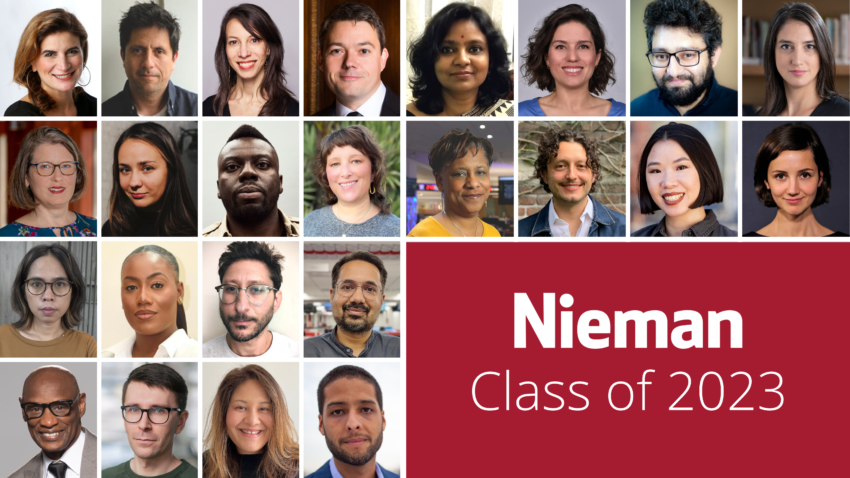
Nieman Announces Diverse Class for 2023
“The Nieman Foundation for Journalism has selected 24 journalists from around the world for a year of study at Harvard University,” the foundation announced Wednesday. “The new Nieman Fellows will work on projects about government suppression of journalism, controlling misinformation, climate change, migration and more.
“The Nieman class of 2023 includes the foundation’s first Cambodian journalist, as well as others who report on Ukraine, Russia, Afghanistan, Turkey, Myanmar, Bangladesh, India, Mexico, Nigeria and Hong Kong — places where press freedom is tightly restricted or under attack and in dire need of external support. . . .”
Among the class will be Danny Fenster, editor-at-large for Frontier Myanmar, an investigative news magazine, who was imprisoned by Myanmar’s junta for nearly six months in 2021 for his reporting on military-linked businesses. He plans to study how journalists in exile are using emerging digital tools to continue reporting on repressive regimes, as well as the impact of Western foreign policy responses to these governments on reporters’ ability to continue working.
Taras Prokopyshyn, publisher and CEO of The Ukrainians Media in Lviv, Ukraine, was also chosen. He is to study how to build sustainable independent media companies that provide high-quality journalism in developing countries.
60 Ukrainians Apply for Hampton’s Free Summer
Sixty Ukrainians have applied for Hampton University’s offer of free room, board and tuition for the summer session, in what the historically Black university calls “a humanitarian effort to help those college students and families affected by the current conflict in Ukraine,” Margaret Dismond Martin, chair of the Hampton University Ukrainian Initiative, told Journal-isms last week.
None have applied specifically to the Scripps Howard School of Journalism and Communications, she said. The deadline for applications is May 15. After the summer session, the students ” have the option to stay at Hampton at the regular tuition and fees rates,” according to the original announcement. The university said it was setting aside 50 to 100 seats.
Dreams Validated at Pulitzers
May 9, 2022
Journalists of Color See Work Rewarded
Nominate a J-Educator Who Promotes Diversity
From May 8:
Facebook to Let J-Scholarship Program End:
Some NAHJ Leaders Uneasy About the Connection
No Asian Americans On-Air in 25% of Top Markets
Multiple Reasons for Failure of Black News Channel
Layoffs at Short-Lived Netflix Unit
Kudos for Detailing Tucker Carlson’s Racism
Not What’s in the Bridal Magazines
Increase in Blaming Asian Americans for COVID
Black Churches Plan to Mobilize Over ‘Roe’
L.A. Uprising: ‘Race Made My Editors Nervous’
An Idea: Build Community Into Crime Coverage
‘Everything’s Racist’
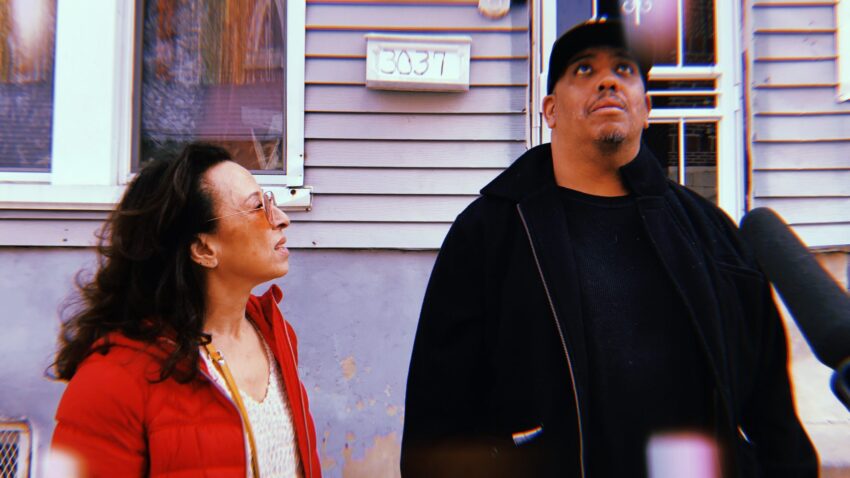
Journalists of Color See Work Rewarded
Journalists of color and their hopes, dreams and achievements won recognition in Pulitzer Prize announcements Monday. They were honored for their investigative reporting, their photographic and management skills and for the work of a journalist who left the mainstream media because too many important stories were going unreported. So she started her own company.
That journalist was Maria Hinojosa, a former NPR reporter who in 2010 started Futuro Media, which produces public radio’s “Latino USA” and has located its headquarters in Harlem.
The staff of Futuro Media, with PRX in Boston, won in the audio reporting category for “Suave,” “a brutally honest and immersive profile of a man reentering society after serving more than 30 years in prison.”
The podcast summary says of Hinojosa and David Luis “Suave” Gonzalez, “What starts as a brief conversation leads to decades of communication between the two, walking the boundary between a journalist-source relationship and true friendship.”
On Twitter, Hinojosa could not contain her joy.
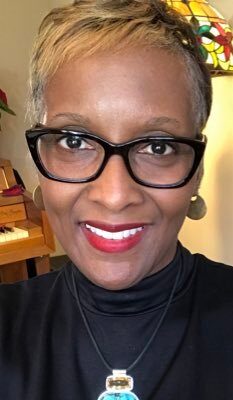 Monica R. Richardson (pictured) had been executive editor of The Miami Herald — the first African American top editor in the Herald’s 117-year history — for barely six months when “Miami awoke to the stunning, heartbreaking news of the sudden collapse of Champlain Tower South in Surfside overnight in June,” as the Herald recalled Monday. The condo catastrophe killed 98 people.
Monica R. Richardson (pictured) had been executive editor of The Miami Herald — the first African American top editor in the Herald’s 117-year history — for barely six months when “Miami awoke to the stunning, heartbreaking news of the sudden collapse of Champlain Tower South in Surfside overnight in June,” as the Herald recalled Monday. The condo catastrophe killed 98 people.
The Herald won the Pulitzer for breaking news. “As a newsroom, we poured our hearts into the breaking news and the ongoing daily coverage, and subsequent investigative coverage,” Richardson said in a statement. “We were relentless in covering the news, delivering context, insights and information available nowhere else and we did it all knowing we were doing it for a community that depended on us for answers. We were the news source that other news sources around the world followed. . . .
“Receiving this prestigious award shows the power and impact of local journalism. This Pulitzer comes with a mixture of sadness and gratification. . . .”
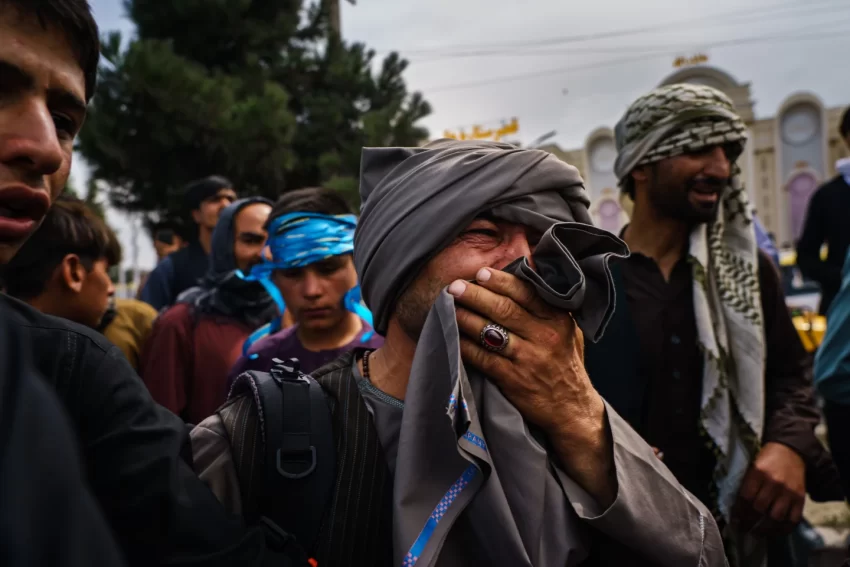
For breaking news photography, Marcus Yam, “a Los Angeles Times journalist with a warrior’s courage and a poet’s heart,” in the words of the Times’ James Rainey, was one of two winners in the category “for his poignant and searing pictures of last summer’s fall of Kabul, Afghanistan, to Taliban fighters.”
 Malaysia-born Yam (pictured), who started in the news business as a photo intern at The New York Times, “delivered pictures of unspeakable tragedy and abiding emotion despite a manhandling by one of the insurgents, the near-constant menace of other fighters and the abundant technical hurdles of transmitting images out of a war zone,” Rainey wrote. It was one of several honors for Yam this year.
Malaysia-born Yam (pictured), who started in the news business as a photo intern at The New York Times, “delivered pictures of unspeakable tragedy and abiding emotion despite a manhandling by one of the insurgents, the near-constant menace of other fighters and the abundant technical hurdles of transmitting images out of a war zone,” Rainey wrote. It was one of several honors for Yam this year.
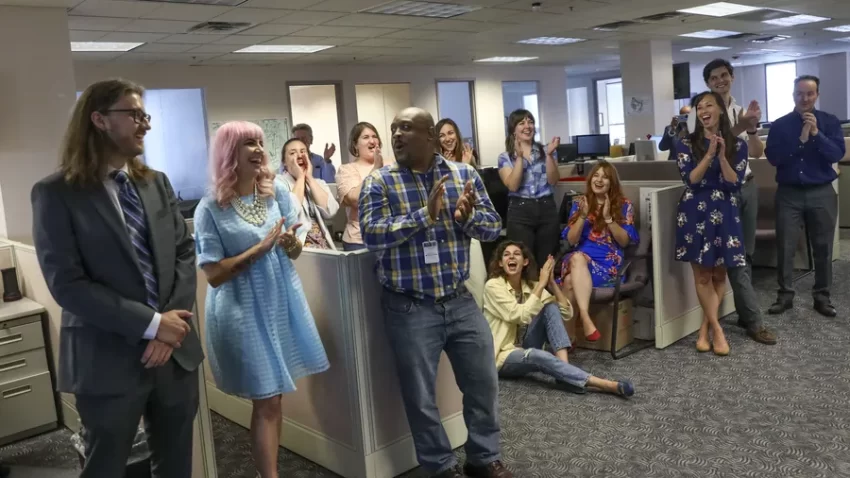
At the Tampa Bay Times, “reporters Corey G. Johnson, Rebecca Woolington and Eli Murray have won . . . in the investigative reporting category for exposing dangers at a Tampa factory, the state’s only lead smelter. The series, ‘Poisoned,’ prompted widespread action,” the Times wrote.
“The reporters detailed the exposure to the neurotoxin endured by Gopher’s workers, most of whom were Black or immigrants. Johnson, Woolington and Murray also showed that the plant had contaminated the community. All three reporters even became certified lead inspectors during the course of their investigation.”
At the Journal-isms Roundtable Feb. 27, when he was toasted after receiving a George K. Polk Award, Johnson said he was humbled. “I hope it will spur newsrooms to give people like me and people who look like me and others opportunities to do investigative reporting and tell some of these more difficult stories,” he said. (video). Johnson is headed for ProPublica.
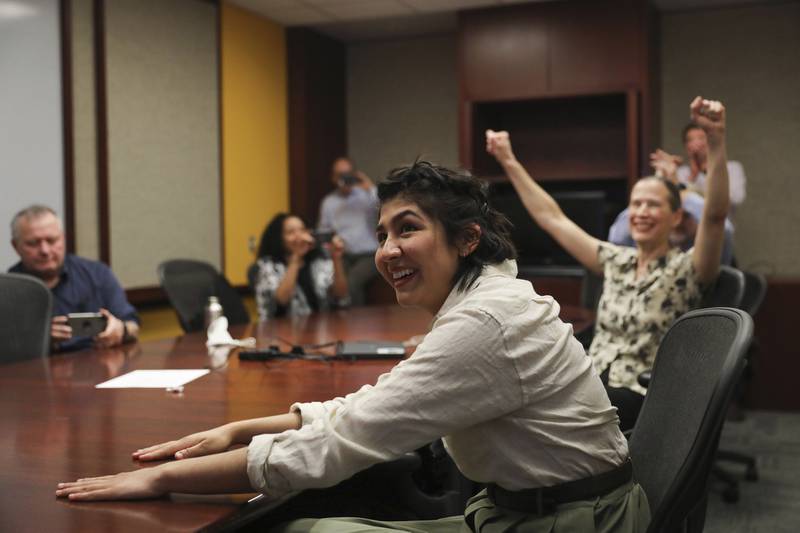
Reporters Cecilia Reyes of the Chicago Tribune and Madison Hopkins of the Better Government Association “revealed that at least 61 men, women and children died in 42 fires in buildings where Chicago officials had been warned — often repeatedly — of major fire safety issues,” the Tribune wrote. “They also documented systemic shortfalls in Chicago’s building enforcement program, revealing a convoluted system of informal rules, outdated records and lax oversight that put the interests of landlords above the safety of tenants. Many of the city’s failures, the reporters found, directly contributed to the deaths.”
Three honors for The New York Times similarly touched on race:
“An investigation . . . into deadly police encounters was recognized for national reporting,” the Times’ Katie Robertson wrote.
“Salamishah Tillet, a contributing critic at large for The Times, won the criticism category for her writing on race in arts and culture. . . .
“Another Times reporter, Andrea Elliott, won the Pulitzer Prize in the general nonfiction category for her book ‘Invisible Child: Poverty, Survival and Hope in an American City,’ which was published by Random House and originated with a 2013 series she did at The Times.”
There were others with racial subtexts. In the commentary category, Melinda Henneberger, as a member of the Kansas City Star editorial board, won “for columns that demanded justice for alleged victims of former Kansas City, Kansas, detective Roger Golubski, who is accused of extorting Black women for sexual favors, sometimes using them to fabricate evidence in cases he was handling,” the Star’s Luke Nozicka reported.
Henneberger joined The Sacramento Bee as a columnist this week. The Star and the Bee are McClatchy publications.
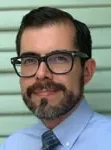 The award for editorial writing went to “Lisa Falkenberg, Michael Lindenberger, Joe Holley and Luis Carrasco (pictured) of the Houston Chronicle for a campaign that, with original reporting, revealed voter suppression tactics, rejected the myth of widespread voter fraud and argued for sensible voting reforms,” the judges said. Carrasco is now at the Seattle Times.
The award for editorial writing went to “Lisa Falkenberg, Michael Lindenberger, Joe Holley and Luis Carrasco (pictured) of the Houston Chronicle for a campaign that, with original reporting, revealed voter suppression tactics, rejected the myth of widespread voter fraud and argued for sensible voting reforms,” the judges said. Carrasco is now at the Seattle Times.
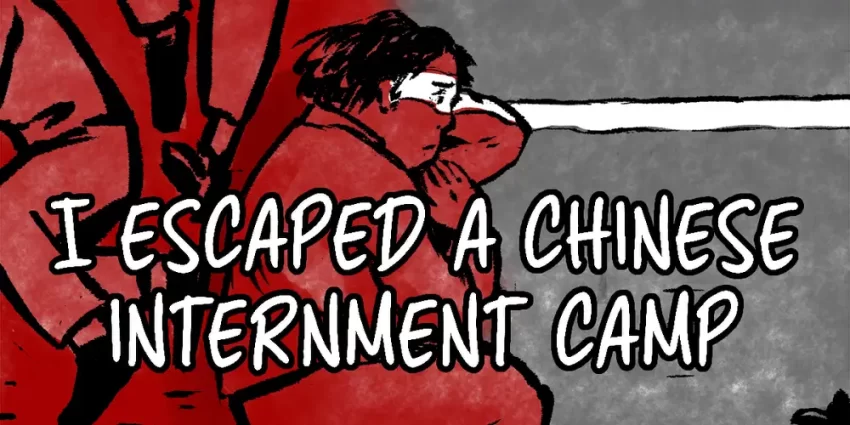
Among the awards for international issues, Fahmida Azim, Anthony Del Col, Josh Adams and Walt Hickey of Insider were honored in the “Illustrated Reporting and Commentary” category for “using graphic reportage and the comics medium to tell a powerful yet intimate story of the Chinese oppression of the Uyghurs, making the issue accessible to a wider public.“
Marjorie Miller, the Pulitzer administrator who announced the awards, did not address the open letter signed two weeks ago by dozens of professional journalism organizations, nonprofits and labor unions asking the Pulitzers to add language requiring newsrooms to participate in the News Leaders Association’s annual diversity survey (or one similar) by 2024 in order to be considered for their journalism awards.
Winning stories also focused on threats to democracy, such as the Jan.6 riot at the U.S. Capitol, for which The Washington Post won the public service award, and wars abroad. Fearless Ukrainian journalists received a special citation.
“These stories sometimes right injustice, sometimes they illuminate a deeper context of the local communities in which we live. Sometimes they surprise and entertain,” John Daniszewski, the Associated Press vice president and editor at large for standards and co-chair of the Pulitzer Prize Board, said in his introduction to the event.
But what the journalism has in common “is that it was done ethically and seriously, and in its enterprise has [played] a part in keeping our democracies vibrant.”
- List of winners, including non-journalism awardees
- David Folkenflik, NPR: ‘The New York Times’ can‘t shake the cloud over a 90-year-old Pulitzer Prize
- Amy Goodman and Juan Gonzalez with Maria Hinojosa and David Luis “Suave” Gonzalez, “Democracy Now!”: Maria Hinojosa, Futuro Media & PRX Win Pulitzer for “Suave” Podcast on Prisoner’s Journey to Freedom (May 10)
- Vanessa Romo, NPR: Winner praises the Pulitzer board’s commitment to the ‘heart’ in journalism (May 10)
Nominate a J-Educator Who Promotes Diversity
Beginning in 1990, the Association of Opinion Journalists, now part of the News Leaders Association, annually granted a Barry Bingham Sr. Fellowship — actually an award — “in recognition of an educator’s outstanding efforts to encourage minority students in the field of journalism.”
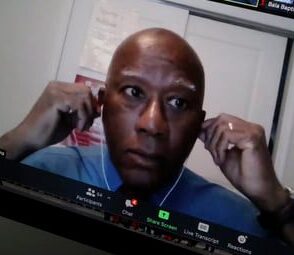 Since 2000, the recipient has been awarded an honorarium of $1,000 to be used to “further work in progress or begin a new project.”
Since 2000, the recipient has been awarded an honorarium of $1,000 to be used to “further work in progress or begin a new project.”
Past winners include James Hawkins, Florida A&M University (1990); Larry Kaggwa, Howard University (1992); Ben Holman, University of Maryland (1996); Linda Jones, Roosevelt University, Chicago (1998); Ramon Chavez, University of Colorado, Boulder (1999); Erna Smith, San Francisco State (2000); Joseph Selden, Penn State University (2001); Cheryl Smith, Paul Quinn College (2002); Rose Richard, Marquette University (2003).
Also, Leara D. Rhodes, University of Georgia (2004); Denny McAuliffe, University of Montana (2005); Pearl Stewart, Black College Wire (2006); Valerie White, Florida A&M University (2007); Phillip Dixon, Howard University (2008); Bruce DePyssler, North Carolina Central University (2009); Sree Sreenivasan, Columbia University (2010); Yvonne Latty, New York University (2011); Michelle Johnson, Boston University (2012); Vanessa Shelton, University of Iowa (2013); William Drummond, University of California at Berkeley (2014); Julian Rodriguez of the University of Texas at Arlington (2015); David G. Armstrong, Georgia State University (2016); Gerald Jordan, University of Arkansas (2017), Bill Celis, University of Southern California (2018); Laura Castañeda, University of Southern California (2019); Mei-Ling Hopgood, Northwestern University (2020); and Wayne Dawkins, Morgan State University (2021) (pictured).
To subscribe at no cost, please send an email to journal-isms+subscribe@groups.io and say who you are.
Facebook users: “Like” “Richard Prince’s Journal-isms” on Facebook.
Follow Richard Prince on Twitter @princeeditor
Richard Prince’s Journal-isms originates from Washington. It began in print before most of us knew what the internet was, and it would like to be referred to as a “column.” Any views expressed in the column are those of the person or organization quoted and not those of any other entity. Send tips, comments and concerns to Richard Prince at journal-isms+owner@
View previous columns (after Feb. 13, 2016).
View previous columns (before Feb. 13, 2016)
- Diversity’s Greatest Hits, 2018 (Jan. 4, 2019)
- Book Notes: Is Taking a Knee Really All That? (Dec. 20, 2018)
- Book Notes: Challenging ’45’ and Proudly Telling the Story (Dec. 18, 2018)
- Book Notes: Get Down With the Legends! (Dec. 11, 2018)
- Journalist Richard Prince w/Joe Madison (Sirius XM, April 18, 2018) (podcast)
- Richard Prince (journalist) (Wikipedia entry)
- February 2018 Podcast: Richard “Dick” Prince on the need for newsroom diversity (Gabriel Greschler, Student Press Law Center, Feb. 26, 2018)
- Diversity’s Greatest Hits, 2017 — Where Will They Take Us in the Year Ahead?
- Book Notes: Best Sellers, Uncovered Treasures, Overlooked History (Dec. 19, 2017)
- An advocate for diversity in the media is still pressing for representation, (Courtland Milloy, Washington Post, Nov. 28, 2017)
- Morgan Global Journalism Review: Journal-isms Journeys On (Aug. 31, 2017)
- Diversity’s Greatest Hits, 2016
- Book Notes: 16 Writers Dish About ‘Chelle,’ the First Lady
- Book Notes: From Coretta to Barack, and in Search of the Godfather
- Journal-isms’ Richard Prince Wants Your Ideas (FishbowlDC, Feb. 26, 2016)
- “JOURNAL-ISMS” IS LATEST TO BEAR BRUNT OF INDUSTRY’S ECONOMIC WOES (Feb. 19, 2016)
- Richard Prince with Charlayne Hunter-Gault, “PBS NewsHour,” “What stagnant diversity means for America’s newsrooms” (Dec. 15, 2015)
- Book Notes: Journalists Follow Their Passions
- Book Notes: Journalists Who Rocked Their World
- Book Notes: Hands Up! Read This!
- Book Notes: New Cosby Bio Looks Like a Best-Seller
- Journo-diversity advocate turns attention to Ezra Klein project (Erik Wemple, Washington Post, March 5, 2014)
When you shop @AmazonSmile, Amazon will make a donation to Journal-Isms Inc. https://t.co/OFkE3Gu0eK
— Richard Prince (@princeeditor) March 16, 2018

